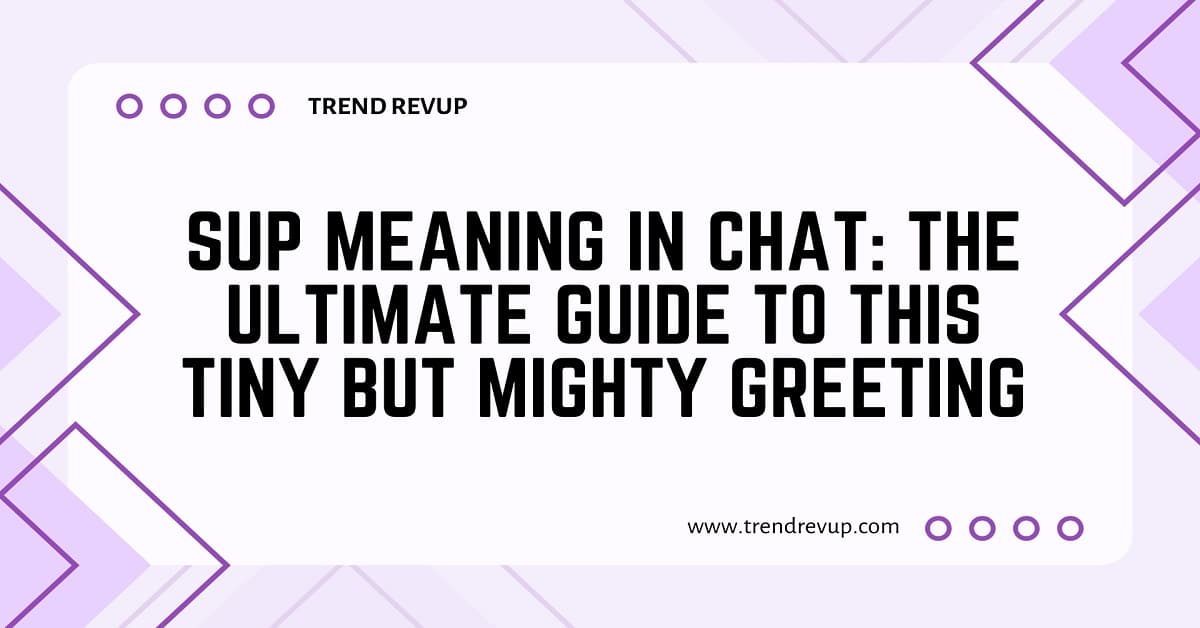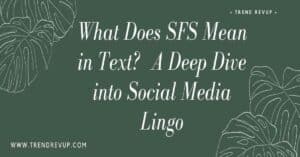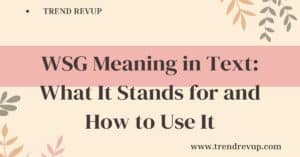Sup meaning in chat might seem obvious, but if you’ve ever paused and wondered what someone really means when they text it, you’re not alone. It’s one of those casual phrases that pop up everywhere, yet it can carry different vibes depending on who’s sending it.
If you’ve been stuck on how to reply without sounding awkward or you just want to know the hidden layers behind this short word you’re in the right place. Let’s break it down so you’ll never second-guess “sup” again.
What Does “Sup” Actually Mean?
Let’s start with the basics, shall we? “Sup” is simply a shortened version of “What’s up?” vwhich itself is already pretty casual. It’s like communication went on a diet and decided to shed all the unnecessary syllables. Think of it as the text equivalent of wearing sweatpants to a Zoom meeting: comfortable, practical, and perfectly acceptable in today’s world.
The beauty of “sup” lies in its versatility. It can mean:
- “Hello, how are you?”
- “What’s happening?”
- “I acknowledge your existence”
- “I’m bored and want to chat”
- “I have news but I’m going to make you ask about it”
It’s remarkable how three letters can carry so much social weight, isn’t it?
The Evolution of Digital Greetings
Remember when people used to write actual letters that started with “Dear Sir or Madam” and ended with “Your most obedient servant”? Yeah, those days are long gone. We’ve gone from elaborate salutations to… “sup.” And honestly? It’s kind of beautiful in its simplicity.
The journey from “What’s up?” to “sup” perfectly mirrors our collective journey toward digital efficiency. We started with full sentences, moved to abbreviations like “wassup,” then “wazzup” (thanks, Budweiser commercials of the early 2000s), and finally landed on the beautifully minimalist “sup.”
It’s like watching language evolve in real time, except instead of taking centuries, it happened in about two decades. Darwin would be fascinated.
When to Use “Sup” (And When Maybe Don’t)
Perfect “Sup” Situations
The Casual Friend Check-in: You haven’t talked to your buddy in a few days, and you want to see what’s going on without seeming too eager or formal. “Sup” is perfect here—it’s like a gentle conversational knock on the door.
The “I’m Bored” Opener: It’s 2 PM on a Tuesday, you’re procrastinating at work, and you need human interaction. “Sup” to three different group chats, and boom instant entertainment potential.
The Sibling Communication: Nothing says “we share DNA but I’m too cool to be formal with you” like hitting your brother or sister with a casual “sup.” It’s familial love wrapped in intentional indifference.
The Group Chat Resurrection: That group chat that’s been dead for weeks? Someone drops a “sup” and suddenly everyone’s sharing memes again. It’s like CPR for conversations.
Maybe Avoid “Sup” Here
Job Interviews: “Sup” probably isn’t the best way to greet your potential future boss, unless you’re applying to be a skateboard shop manager or professional meme curator.
Formal Customer Service: Your bank probably won’t appreciate “sup, where’s my money?” as much as you might think they would.
Meeting Your Partner’s Parents: Save the “sup” for after you’ve established that you’re not a complete disaster of a human being.
Medical Emergencies: “Sup doc, I think I’m having a heart attack” might not convey the appropriate urgency.
The Art of Responding to “Sup”
Ah, the eternal question: someone hits you with “sup,” now what? This is where things get interesting because responding to “sup” is like a tiny social dance that everyone somehow learned without instructions.
Classic Response Options
The Mirror: Respond with “sup” right back. It’s like a conversational handshake. Simple, effective, and shows you’re on the same wavelength.
The Elaboration: “Not much, you?” This keeps the door open for actual conversation while maintaining the casual vibe.
The Status Update: “Just chilling at work/home/the moon.” Gives them something to work with if they want to keep talking.
The Question Flip: “What’s good?” or “How’s your day?” Shows you’re interested in actual conversation.
The Meme Response: Send a GIF. Because sometimes pictures really are worth a thousand words, and you don’t have time for that many words.
Advanced “Sup” Response Strategies
For the truly sophisticated “sup” communicator, there are some next-level response techniques:
The Context Clue Drop: “Sup, just recovered from that meeting from hell.” This gives them an opening to ask follow-up questions if they want to dive deeper.
The Activity Bait: “Sup, about to do something stupid.” Now they have to ask what you’re up to. It’s conversational clickbait, and it works.
The Emotional Weather Report: “Sup, feeling like a Tuesday.” Vague enough to be intriguing, specific enough to start a conversation about why Tuesdays are the worst days of the week.
Cultural Variations and Global “Sup” Equivalents
While “sup” might be distinctly American in its origins, the concept of ultra-casual greetings has gone global. Different cultures have their own versions of this minimalist masterpiece:
In British texting culture, you might see “alright?” which serves the same function it’s a greeting disguised as a question that doesn’t really expect a detailed health report.
Australian chat culture gave us “how ya going?” often shortened to just “howya,” which is basically “sup” with an accent and more vowels.
Even in non-English speaking countries, the influence of “sup” has been felt. You’ll find borrowed English casual greetings mixed into local chat languages, creating beautiful hybrid expressions that would make linguists either very excited or very concerned.
The Psychology Behind “Sup”
There’s actually some fascinating psychology behind why “sup” works so well in digital communication. It hits that sweet spot between showing interest and maintaining coolness. It’s invested enough to start a conversation but casual enough that if the other person doesn’t respond, nobody’s feelings are hurt.
“Sup” is also brilliantly ambiguous. It can be a genuine inquiry about someone’s wellbeing, a bored attempt at starting conversation, or just a casual acknowledgment of someone’s existence. This ambiguity is actually a feature, not a bug it gives both parties room to steer the conversation in whatever direction feels right.
It’s like the conversational equivalent of wearing sunglasses. You’re engaged, but with just enough cool detachment to maintain your dignity if things don’t go as planned.
Common “Sup” Misconceptions
Myth 1: “Sup” Means Someone Doesn’t Care
Wrong! Often, “sup” is actually a sign that someone is comfortable enough with you to drop the formalities. It’s casual intimacy, not indifference.
Myth 2: Only Young People Use “Sup”
While “sup” might have started with younger generations, it’s now used by everyone from teenagers to that cool uncle who still thinks he’s hip. Age is just a number, but “sup” is universal.
Myth 3: “Sup” Is Too Informal for Any Serious Relationship
Not true! Long-term couples, close friends, and family members often use “sup” because they’re past the need for elaborate greetings. Sometimes “sup” means “I love you but I’m too comfortable with you to be fancy about it.”
Myth 4: You Have to Respond to “Sup” Immediately
The beauty of “sup” is its low-pressure nature. It’s not demanding an immediate response like “URGENT!!!” or “call me NOW.” It’s patient. It can wait.
The Future of “Sup”
Where does “sup” go from here? Will it get even shorter? Will we eventually just communicate through single letters? Will “s” become the greeting of 2030?
Probably not, because “sup” has achieved something rare in digital communication: it’s found the perfect balance between efficiency and warmth. It’s short enough for our shortened attention spans but long enough to feel human.
As our communication continues to evolve, “sup” has carved out its place as the reliable, go-to greeting that works in almost any casual situation. It’s the little black dress of digital hellos—simple, versatile, and always appropriate for the occasion.
Mastering the “Sup” Lifestyle
Using “sup” effectively isn’t just about the word itself it’s about embracing a whole philosophy of communication. It’s about being comfortable with casual connections, understanding that not every conversation needs to be deep and meaningful, and recognizing that sometimes the best way to show you care is to keep things simple.
The “sup” lifestyle is about being approachable without being needy, interested without being overwhelming, and cool without being cold. It’s a delicate balance, but when you get it right, you become the kind of person others feel comfortable reaching out to.
Conclusion: The Mighty Power of “Sup”
So there you have it—the complete guide to “sup” meaning in chat. From its humble beginnings as a shortened “what’s up?” to its current status as the Swiss Army knife of greetings, “sup” has proven that sometimes the smallest words carry the biggest impact.
Whether you’re a “sup” veteran or someone who’s been intimidated by its casual coolness, remember that at its heart, “sup” is just one person reaching out to another person and saying, “Hey, you exist, and I acknowledge that existence.” In our increasingly digital world, that’s actually pretty beautiful.
Next time someone hits you with a “sup,” take a moment to appreciate the elegant simplicity of it. They could have written a novel, but instead, they chose three perfect letters that say everything and nothing all at once.
Now I’m curious what’s your go-to response to “sup”? Are you a classic mirror responder, an elaborate storyteller, or do you have your own unique style? And more importantly, do you think we’ll ever find a greeting more perfectly efficient than “sup”? Drop your thoughts in the comments or you know, just hit me with a simple “sup.” I’ll know what you mean.
For more visit: https://trendrevup.com/



